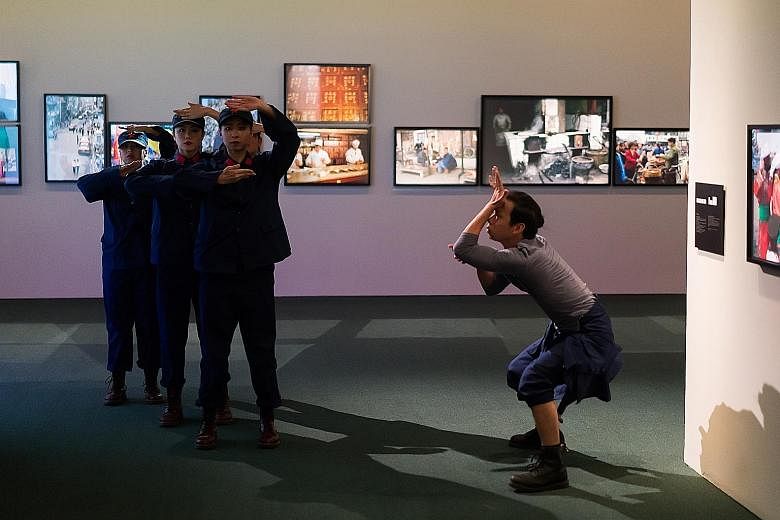REVIEW / DANCE
SHAMAN/PEASANTS - DANCE OF THE BAREFOOT GUARDIANS
Arts Fission
NTU Centre for Contemporary Art Singapore/Last Friday
The renewed eagerness and vitality of the company dancers left a deep impression at Arts Fission's latest site-specific performance, Shaman/ Peasants - Dance Of The Barefoot Guardians.
The young dancers moved with a solidarity that was pleasing to the eye. They brought out artistic director Angela Liong's signature swift and gestural movement style. Clear physical impulses and accents drove the dancers' limbs powerfully into space and, at times, lifted them into the air in a series of rapid whirls before collapsing onto the ground.
As solos took place in various parts of the space, a group of female dancers, dressed in Chinese Mao- era comrade uniforms, marched fervently, weaving between the audience members scattered about the NTU Centre for Contemporary Art (NTU CCA) at Gillman Barracks.
The CCA is exhibiting German artist Ulrike Ottinger's extensive collection of photos and films of the people and landscapes of China in the 1980s and 1990s. Liong's dance, which took place in the gallery, was a response to the exhibition.
Dancers' commendable performance aside, Liong's choreography tried to dialogue with the images in the exhibition, but did not make much headway.
Ottinger's powerful images eclipsed the dancing at many points. Their poetic nature etched a deeper impression than the dance. Perhaps it was the mobile nature of Liong's choreography, with dancers flitting quickly from one space to another, that did not allow the live, moving bodies to assert themselves as solidly as Ottinger's photographs and films.
-
BOOK IT / SHAMAN/ PEASANTS - DANCE OF THE BAREFOOT GUARDIANS
-
WHERE: NTU Centre for Contemporary Art Singapore, Gillman Barracks, Block 43 Malan Road
WHEN: July 28, 5 and 7.30pm. Exhibition (China. The Arts - The People) runs till Aug 13; Tuesdays to Thursdays and weekends, noon to 7pm; Fridays, noon to 9pm
ADMISSION: $15 for Shaman/ Peasants; exhibition is free
INFO: Tickets from www.globaltickets.sg; for details, go to www.facebook.com/artsfission.company or www.ntu.ccasingapore.org
Also unclear was the introduction of characters into the choreography. The group of marching female Mao-era comrades; a high- heeled vixen referred to in the performance programme as the "Bourgeois Witch"; a faceless shaman dressed in a billowing gown of ribbons - these were some of the quirky characters. They hinted at many cultural and political aspects of China, but did not expound on these ideas. Consequently, they seemed incongruous beside one another as they took turns jostling for the audience's attention.
It was clear that these characters were inspired by the images in the exhibition. At certain points, it felt like some people in the photos and films popped out of the two-dimensional images and into the threedimensional performance space. Unfortunately, other than being a three-dimensional echo or visual complement to the images, it was hard to see or read anything else from the performance.
One of the most striking things about this show is the immense size and complexity of the Chinese culture that Ottinger's images reveal. The 1980s and 1990s were a significant period of modernisation for China. Liong's works often foreground complex cultural themes, so it would seem like she was the perfect person to tackle a response to an exhibition of such a nature. Yet, it fell short.
The Chinese culture as diasporic and complex, and a deeper investigation into the Chinese identity today as opposed to the 1980s - these are some angles that come to mind immediately in response to Ottinger's European look at China in the 1980s and 1990s. But, alas, a richer, more multi-layered response was absent in Liong's work.

